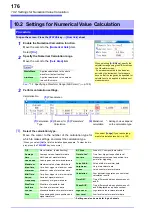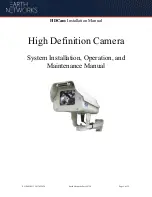
10.6 Numerical Calculation Type and Description
186
Rise Time and
Fall Time
The rise time of the acquired waveform from
A% to B% (or fall time from B% to A%) is ob-
tained by calculation using a histogram (fre-
quency distribution) of the 0 and 100%
levels of the acquired waveform.
As waveform data is acquired, the rise time
(or fall time) is obtained from the first rising
(or falling) edge.
When calculation of the range specified by
the A/B cursors is selected, the obtained
rise time (or fall time) is the first rising (or
falling) edge between the cursors.
Standard Deviation
(Std Dev)
Obtains the standard deviation of the waveform data.
Area
Obtains the area value (V•s) enclosed by
the zero position (point of zero potential)
and the signal waveform.
When calculation of the range specified by
the A/B cursors is selected, the calculated
area is constrained to the waveform be-
tween the cursors.
X-Y Area
Obtains the area (V
2
) of an X-Y composite waveform. In the following figures, the areas
within the lines are calculated. The calculation is available even if the X-Y composite
waveform is not intended for display.
To enable area calculation, specify the calculation range using the A/B cursors (Voltage
axis or Trace) on the waveform of each channel for X-Y composition. (The area cannot
be specified directly by A/B cursors on the X-Y waveform.)
See:
About A/B Cursor:"7.1 Reading Measurement Values (Using the A/B Cursors)"
(
Setting Choices: Set the X- and Y-axis channels.
Numerical Calculation
Type
Description
Fall Time
Rise Time
B%
A%
A: 5 to 30%
B: 95 to 70%
σ
1
n
---
di
AVE
–
(
)
2
i
1
=
n
=
σ
: Standard Deviation
AVE: Average
n: Data count
di: Data on channel number i
A cursor
B cursor
Area of shaded po
S
di
i
1
=
n
=
h
•
S: Area
n: Data count
di: Data on channel number i
h=
Δ
t: Sampling rate
Start/end point
S = n x s0
S: Area
n: Number of loops
When the trace consists of multiple
loops
When the trace is an open curve
End point
S = s0
S: Area
(Area enclosed by the curve
and line connecting start
and end points)
Start
point
s0
s0
S = | s0 - s1|
S: Area
When the trace is a figure-8
When the trace is an open curve
End
point
S = s0 x 2 + s1
S: Area
(The number of overlapping
regions increases with the
number of loops)
Start
point
s0
s1
End point
Start
point
s1
s0
Summary of Contents for 8847
Page 1: ...MEMORY HiCORDER Instruction Manual 8847 December 2010 Revised edition 4 8847A981 04 10 12H ...
Page 2: ......
Page 18: ...Operating Precautions 8 ...
Page 26: ...1 4 Basic Key Operations 16 ...
Page 74: ...4 4 Waveform Observation 64 ...
Page 98: ...5 5 Managing Files 88 ...
Page 110: ...6 6 Miscellaneous Printing Functions 100 ...
Page 126: ...7 8 Seeing Block Waveforms 116 ...
Page 160: ...8 10 Making Detailed Settings for Input Modules 150 ...
Page 198: ...10 6 Numerical Calculation Type and Description 188 ...
Page 296: ...15 7 Controlling the Instrument with Command Communications LAN USB 286 ...
Page 304: ...16 2 External I O 294 ...
Page 362: ...Appendix 5 FFT Definitions A28 ...
Page 368: ...Index Index 6 ...
Page 369: ......
Page 370: ......
Page 371: ......
















































